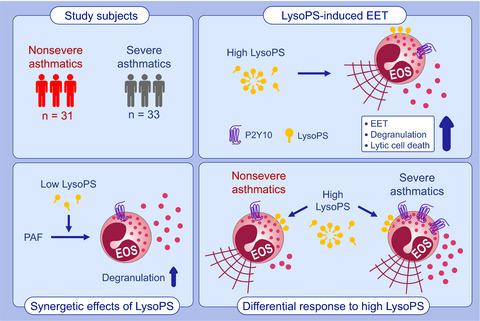Our official English website, www.x-mol.net, welcomes your
feedback! (Note: you will need to create a separate account there.)
Lysophosphatidylserine induces eosinophil extracellular trap formation and degranulation: Implications in severe asthma
Allergy ( IF 12.6 ) Pub Date : 2020-07-10 , DOI: 10.1111/all.14450 Hye Jeong Kim 1 , Myeong Seong Sim 1 , Dong Hyun Lee 2 , Chun Kim 3 , Youngwoo Choi 2 , Hae-Sim Park 2 , Il Yup Chung 1, 3
Allergy ( IF 12.6 ) Pub Date : 2020-07-10 , DOI: 10.1111/all.14450 Hye Jeong Kim 1 , Myeong Seong Sim 1 , Dong Hyun Lee 2 , Chun Kim 3 , Youngwoo Choi 2 , Hae-Sim Park 2 , Il Yup Chung 1, 3
Affiliation

|
Recent evidence demonstrates that activated eosinophils undergo a distinct form of lytic cell death, accompanied by formation of DNA‐based eosinophil extracellular trap (EET) and degranulation, enhancing inflammatory immune responses in asthmatic airways. We previously showed that human blood eosinophils undergo degranulation in response to lysophosphatidylserine (LysoPS), an inflammatory lipid mediator, and strongly express P2Y10, a LysoPS receptor.
中文翻译:

溶血磷脂酰丝氨酸诱导嗜酸性粒细胞胞外陷阱形成和脱颗粒:对严重哮喘的影响
最近的证据表明,活化的嗜酸性粒细胞经历了一种不同形式的裂解细胞死亡,伴随着基于 DNA 的嗜酸性粒细胞胞外陷阱 (EET) 和脱颗粒的形成,增强了哮喘气道的炎症免疫反应。我们之前表明,人血嗜酸性粒细胞会因溶血磷脂酰丝氨酸 (LysoPS)(一种炎症脂质介质)而发生脱粒,并强烈表达 P2Y10(一种 LysoPS 受体)。
更新日期:2020-07-10
中文翻译:

溶血磷脂酰丝氨酸诱导嗜酸性粒细胞胞外陷阱形成和脱颗粒:对严重哮喘的影响
最近的证据表明,活化的嗜酸性粒细胞经历了一种不同形式的裂解细胞死亡,伴随着基于 DNA 的嗜酸性粒细胞胞外陷阱 (EET) 和脱颗粒的形成,增强了哮喘气道的炎症免疫反应。我们之前表明,人血嗜酸性粒细胞会因溶血磷脂酰丝氨酸 (LysoPS)(一种炎症脂质介质)而发生脱粒,并强烈表达 P2Y10(一种 LysoPS 受体)。


















































 京公网安备 11010802027423号
京公网安备 11010802027423号